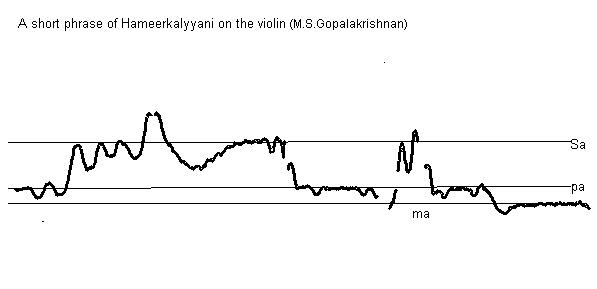
Click on the picture to hear the phrase.
Though succession of notes is the basis of all melodic music, Carnatic music has 2 special features. Notes are smoothly connected without break to form phrases. Nuances or oscillations between notes and around notes ('Gamakams') are used to add to the expression. The notation for a lyric if played as a succession of notes would hardly be recognised. Listen to the first part of the song 'Akshaya linga' which uses all white notes (with C or 1 kattai as Aadhaara Sruthi) and the same set of notes played with break only at the consonants in the lyric. A further enhancement is achieved by adding oscillations or 'Gamakams'. Look at a pitch graph of a short phrase in Raagam Hameerkalyaani. You can click on the picture to hear the phrase. Listen another example of extensive Gamakams - phrases of Raagam Saaveri. More on Gamakams later.
Raagam is the central concept of Carnatic Music. Raagam may be said to be a melodic mood. Indian music tends to dwell on a single mood or emotion for considerable length of time (one of the reasons for repeating phrases without change or with slight change -'Sangathis'). Carnatic music songs are always set to some Raagam (sometimes to a succession of Raagams) but the Raagam can also be sung as phrases without a lyric (Aalaapana).
Technically a Raagam is defined by the choice of notes (from among the 12 notes), their ascending and descending sequences called Aarohanam and Avarohanam, the nature of Gamakam (or absence of it) on different notes and by characteristic phrases or groups of notes, the last because in Carnatic music Raagams are highly phrase oriented. While the notes provide the skeleton of the Raagam , the Gamakams and the manner in which notes are used are its 'flesh and blood'.